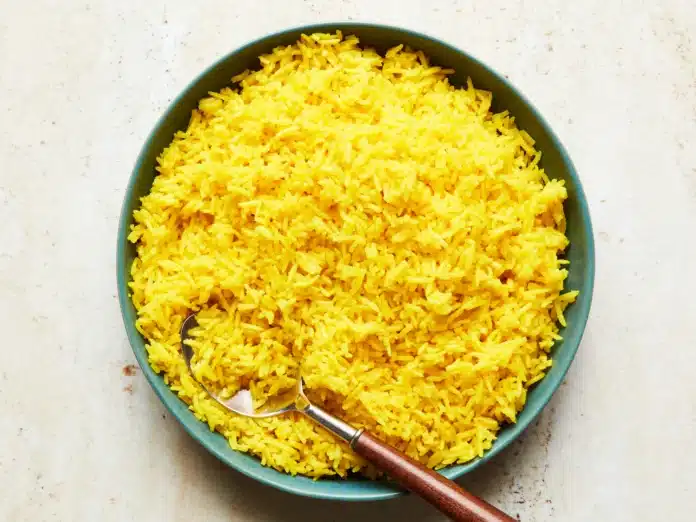Saffron rice is a common dish across many areas of the world. Most commonly, it is used in India, Bangladesh, Pakistan and other parts of South Asia. It is also found in Persian and Middle Eastern cooking and even in other parts of Asia, such as in Thai cooking (made with jasmine rice and mixed with fish sauce).
Traditionally it is made with white basmati rice and can be found in both sweet & savoury versions.
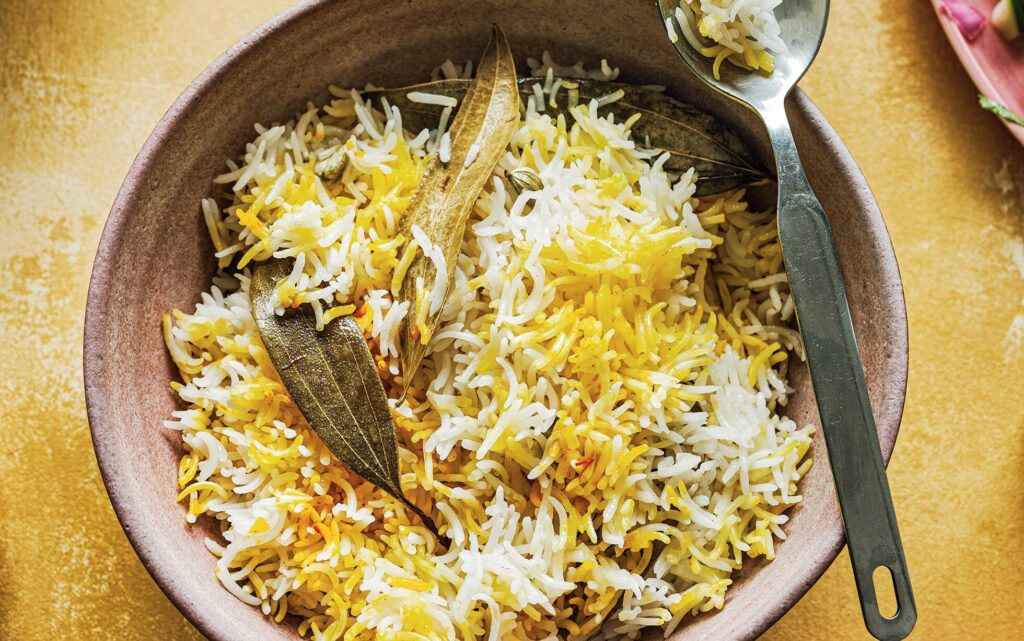
SEE ALSO:
- How to make Sushi Burrito: Homemade Sushi Recipe
- Matar Paneer Recipe: (How to Make Mutter Paneer)
- Best Homemade German Chocolate Cake Recipe
What is Saffron Rice?
Saffron rice is a dish made from saffron, white rice, and vegetable bouillon. Saffron rice is found in the cuisines of many countries (in one form or another). The recipe is similar to plain cooked rice with the addition of ingredients.
Saffron rice is a delicious and aromatic rice dish that is flavoured and coloured with saffron. Saffron is a prized spice derived from the stigmas of the crocus flower.
To make saffron rice, long-grain white rice is typically used. The rice is first rinsed to remove excess starch, then cooked in a mixture of water, saffron threads, and sometimes other spices or aromatics like cinnamon, cardamom, or cloves. The saffron infuses the rice with its vibrant colour and unique flavour.
The result is a fragrant and visually appealing rice dish with a yellow or golden hue. Saffron rice is often served as a side dish alongside various meat, poultry, or vegetable dishes. It pairs well with Mediterranean, Middle Eastern, and Indian cuisines but is enjoyed in various culinary traditions worldwide.
Saffron rice is known for its luxurious and exotic taste, making it a popular choice for special occasions or festive meals. The delicate aroma and vibrant colour of saffron add a touch of elegance to the dish, making it visually appealing and flavorful.
READ ALSO: Best Spaghetti Bolognese Recipes you should try (Quick and Easy)
Saffron Rice Significance in Different Cuisine
Saffron rice holds significance in various cuisines around the world, particularly in Middle Eastern, Persian, and Indian cooking. Here are a few examples of its significance in different cuisines:
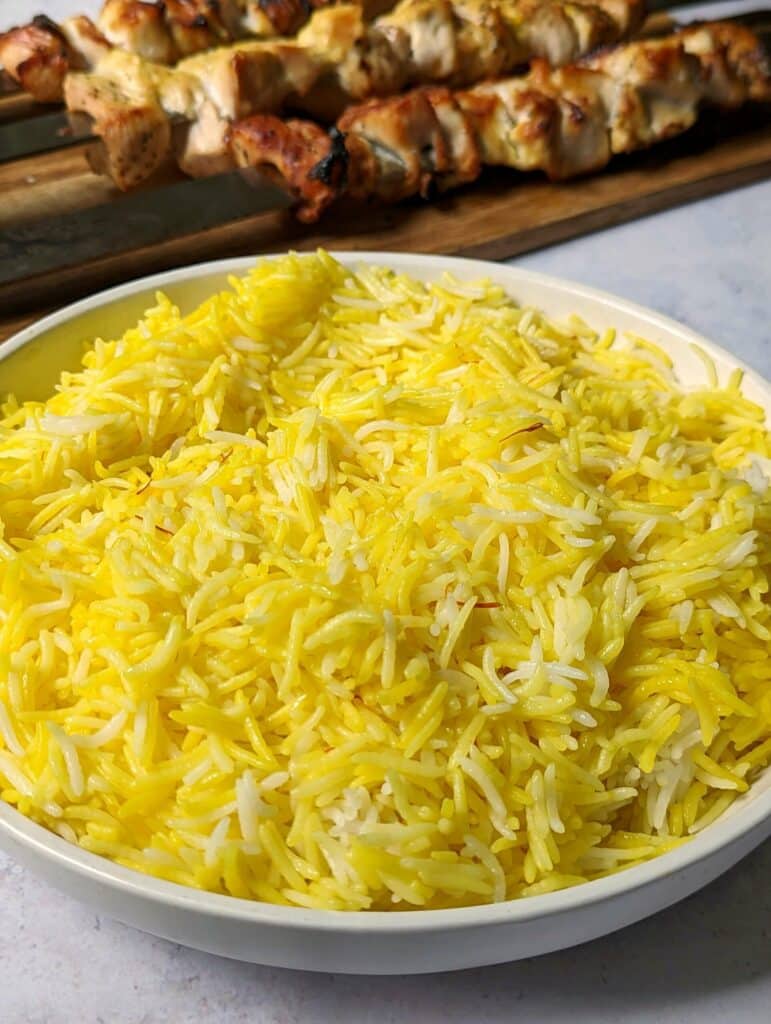
Persian Cuisine:
Saffron rice, known as “Zereshk Polo” or “Jeweled Rice,” is a staple in Persian cuisine. It is often served on special occasions and celebrations.
The rice is cooked with saffron, giving it a bright yellow colour, and it is typically garnished with barberries, pistachios, almonds, and sometimes raisins. This dish is a symbol of luxury, elegance, and celebration in Persian culture.
Indian Cuisine
Saffron rice, commonly called “Kesar Chawal” or “Zafrani Pulao,” is popular in Indian cuisine. It is often served during festive occasions and weddings. Saffron is added to the rice, along with various aromatic spices, nuts, and raisins, to create a fragrant and richly flavoured rice dish. Saffron rice pairs well with Indian curries, biryanis, and kebabs.
Middle Eastern Cuisine
Saffron rice is commonly found in Middle Eastern cuisine, particularly in countries like Saudi Arabia, Iran, and the United Arab Emirates. It is a versatile side dish that complements a variety of Middle Eastern main courses such as grilled meats, stews, and kebabs.
Saffron rice is known for its vibrant colour and delicate flavour, enhancing the overall dining experience.
Spanish Cuisine
In Spain, saffron rice is a key component of the iconic dish called “Paella.” Paella is a traditional Spanish rice dish that typically includes saffron-infused rice, various meats (such as chicken, rabbit, and seafood), vegetables, and aromatic spices.
The saffron gives the rice a bright yellow colour and adds a distinct flavour to the dish, making it a beloved and internationally recognized Spanish delicacy.
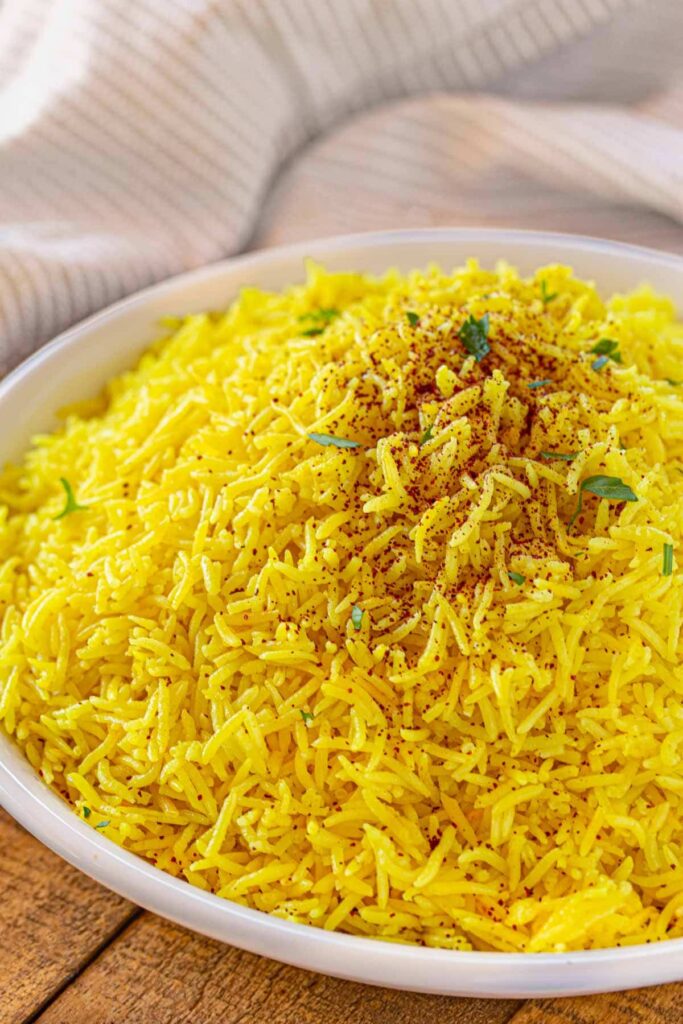
Saffron Rice Recipe
1. Basmati rice:
is a long-grain, aromatic rice perfect for creating fluffy rice dishes?
2. Saffron
This red spice derived from the crocus flower is often sold in dried strands or threads, which are the stigma and styles of the flower. It is an expensive spice so you want to make the most of it!
3. Extra virgin olive oil
High-quality extra virgin olive oil, like our Koroneiki Organic Greek EVOO, is used to fry the onion, garlic and rice before the liquid is added. The olive oil seasons and separates the rice once it is cooked.
4. Broth
You can use vegetable broth, chicken stock, or water as your cooking liquid. While water will work well if you don’t have broth on hand, I prefer broth as it gives a further layer of rich savoriness to the rice.
5. Kosher salt
Salt is essential for flavouring the rice, especially if you’re using water or low-sodium vegetable broth.
6. Yellow or white onion
Finely diced onion adds extra flavour to this saffron rice without distracting from the fluffy texture.
7. Garlic
Garlic and onion are a perfect marriage of flavours—the garlicky notes add further depth to the flavour profile of this yellow rice recipe.
8. Lime zest
The citrus notes provided by the zest give a nice brightness to this dish and complement the saffron. Make sure to zest only the green part of the lime (not the white pith), as the pith can be bitter. If you don’t have lime, lemon can be used in its place.
9. Bay leaf
Bay leaf adds a peppery profile without needing to add pepper, which would make the final dish less aesthetically pleasing.
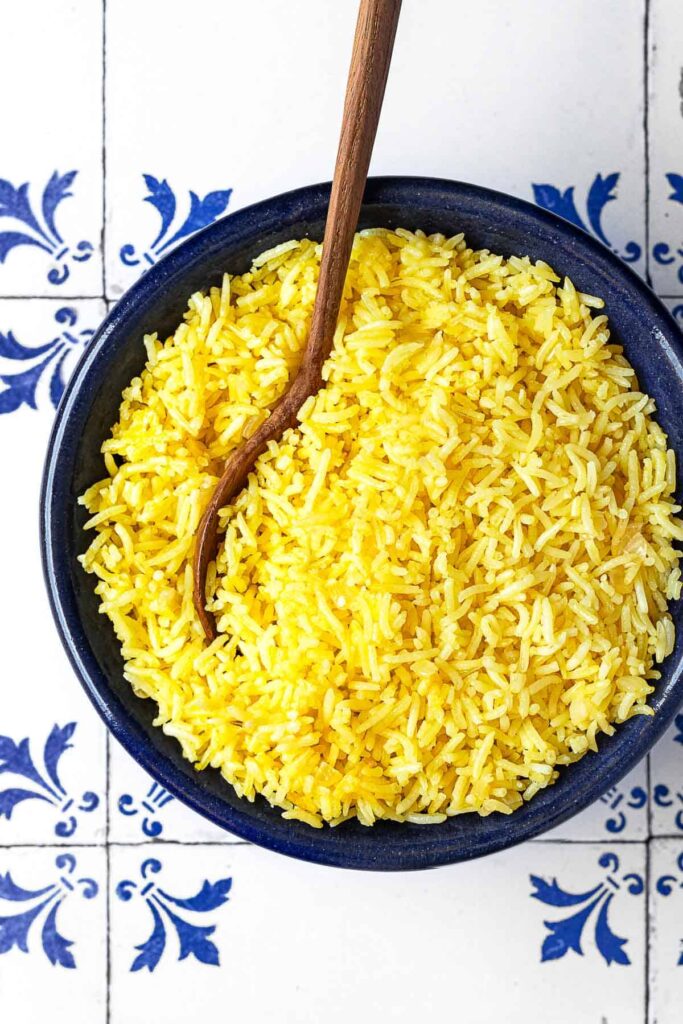
Ingredients
- 3 ½ cups good-quality chicken stock (or vegetable stock)
- ½ teaspoon turmeric
- ½ teaspoon saffron threads
- ¼ to ½ teaspoon dried crushed chile
- 1 squeeze of lemon juice (or lime)
- 2 cups white Thai jasmine rice (or white basmati rice)
- 1 ½ to 2 tablespoons fish sauce, or to taste (or ¼ to ½ teaspoon salt)
Instructions
- Gather the ingredients.
- Pour the stock into a medium-sized pot with a tight-fitting lid. Place the pot on the stove over high heat.
- While the stock is coming to a boil, add the turmeric, saffron, chile (if using), and a squeeze of lemon or lime juice. Stir well.
- Add the rice plus 1 1/2 tablespoons fish sauce (or 1/4 teaspoon salt) and stir. Bring to a boil.
- Reduce the heat to low and cover tightly with a lid. Cook 12 to 15 minutes, or until the rice has absorbed liquid. (Insert a fork or knife straight down into the pot and push the rice aside. If you see liquid, it still needs more time to cook.)
- When most of the liquid is gone, turn off the heat and place the lid on tightly. Allow the pot to remain on the burner for another 5 to 10 minutes or until you’re ready to eat. The residual heat inside the pot will finish steaming the rice. The rice will stay warm in this way for 1 hour or more.
- Before serving, remove the lid and fluff the rice with chopsticks or a fork. Taste test for salt, adding 1/2 tablespoon more fish sauce or a little more salt if needed (the amount will depend on the saltiness of your stock). If the rice tastes too salty, add another squeeze of lemon juice.
SEE: Easy French Toast Recipe to Try Out
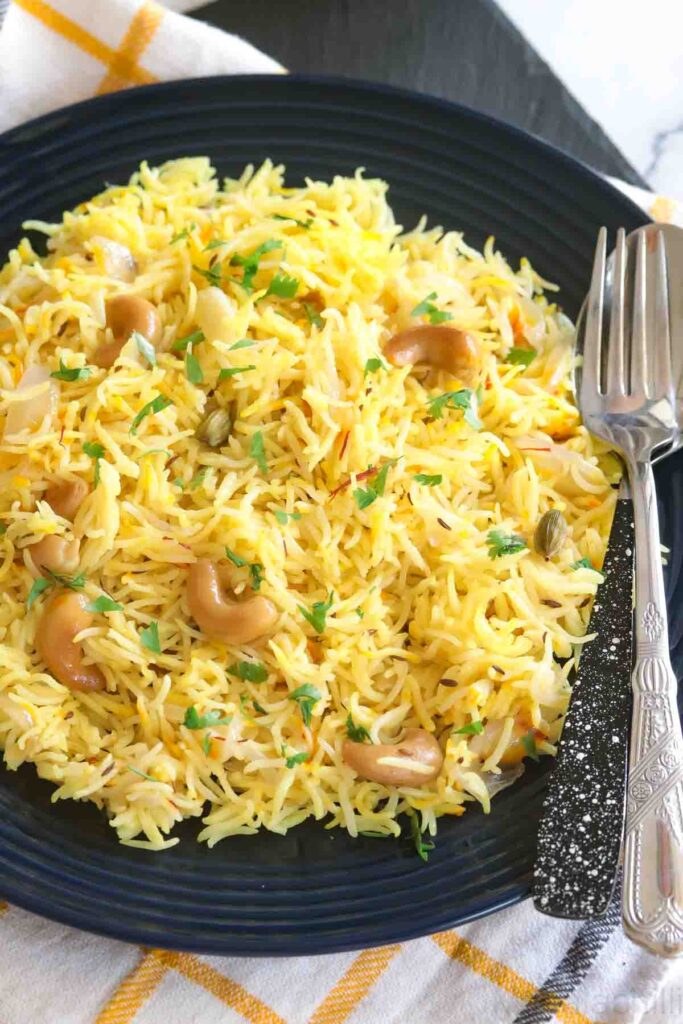
Tips for making Saffron Rice
- Guide to Grinding and Blooming Saffron: For optimal results with saffron, take approximately 10 strands (equivalent to ½ teaspoon) and place them in a spice grinder or mortar and pestle. Grind the saffron strands until they form a fine powder. Next, mix ⅛ teaspoon of the ground saffron with 3 tablespoons of warm water. This process, known as blooming, enhances the spice’s colour and imparts a complex flavour that surpasses using the strands alone.
- Properly Rinse Basmati Rice: Begin by washing the rice in cold water and straining it. Repeat this step a few times until the water runs clear. Rinsing eliminates starch from the rice’s surface, resulting in fluffy and separate grains. Skipping this step may lead to sticky rice.
- Alternative Method for Rinsing Rice without a Fine Mesh Strainer: If you lack a fine mesh strainer or Sieve, you can easily rinse rice using a mixing bowl. Cover the rice with cold water and gently agitate the mixture with your hand. Then slowly pour out the water, allowing gravity to assist in the process. Repeat until the water runs clear.
- Utilize a Non-Stick Pot with Lid: To prevent the saffron rice from sticking to the bottom, it is advisable to use a non-stick pot. The lid is crucial as it helps trap steam once the cooking liquid has been absorbed. If a non-stick pot is unavailable, a well-heated and adequately oiled heavy-bottomed pot can be used as an alternative. In this case, add a full 1 ½ cups of liquid and check during the final few minutes of cooking to ensure the rice is not sticking or burning at the bottom.
- Maintain the Correct Liquid Ratio: The ideal ratio for basmati rice to cooking liquid (water or broth) is 1 cup of rice to 1 ½ cups of liquid. Insufficient liquid will result in undercooked and crunchy rice, while an excess amount will yield overcooked and mushy rice.
- Sauté the Rice before Adding Liquid: Before incorporating the cooking liquid, fry the rice along with onions and garlic in extra virgin olive oil. This process imparts a nutty flavour profile to the rice.
- Season Appropriately: Ensure the rice is well-seasoned with kosher salt, especially when using water or low-sodium broth.
- Allow the Rice to Rest before Serving: After cooking, let the rice sit undisturbed with the lid on for 5 minutes. This resting period allows the rice to absorb the steam, resulting in a fluffy texture. Finally, fluff the rice with a fork to separate the grains before serving.
READ ALSO: 4+ Easy Fish Pie Recipe You Should Try Out This Year
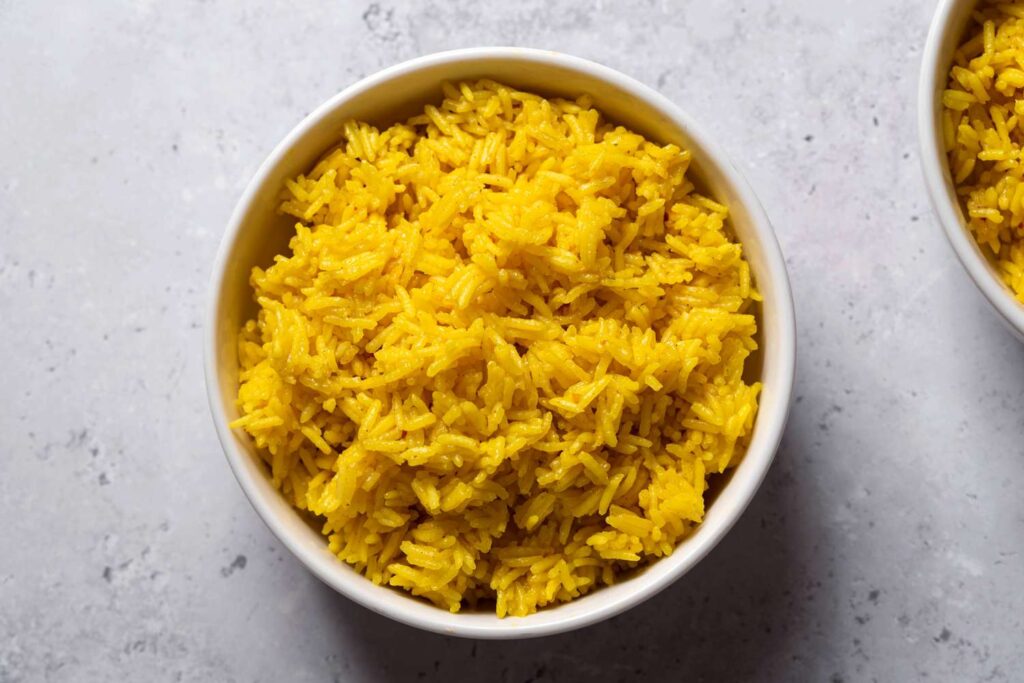
How much Saffron to use?
Saffron is best used sparingly. The flavour is subtly sweet and delicate in small doses with floral and honey notes. But too much can overpower a dish with a bitter flavour. A good rule of thumb is to use about 2-3 threads per serving when making a dish, so for a dish that serves 6, you’ll want to use about 15 threads.
How to cook with saffron?
Cooking with saffron can add a rich, distinct flavour and vibrant colour to your dishes. Here’s a step-by-step guide on how to cook with saffron:
Choose high-quality saffron: Look for saffron threads that are deep red in colour and have a strong aroma. Avoid saffron powder, as it may be less potent.
Prepare the saffron: Take a few saffron threads (around 10-15) and place them in a small bowl. Add a tablespoon of warm water, broth, or milk to the bowl. Let it steep for about 15-20 minutes. This process helps extract the saffron’s flavour, aroma, and colour.
Infuse the liquid: Stir the saffron and the liquid together to ensure the colour and flavour are evenly distributed. Depending on the amount of saffron used, you will notice the liquid turning golden yellow or orange.
Add to your recipe: Saffron can be added to a wide range of dishes, such as rice, stews, soups, risotto, sauces, and desserts. Depending on your recipe, you can directly add the saffron-infused liquid or the saffron threads themselves.
Adjust the quantity: The amount of saffron you use depends on personal preference and the intensity of flavour and colour you desire. Generally, a good starting point is 1/4 to 1/2 teaspoon of saffron threads for a dish serving four people. You can always adjust and add more if needed.
Cooking techniques: Saffron works best with liquid dishes requiring some cooking time. When heated, it releases its flavours and colours, so it’s ideal for simmering, braising, or slow cooking. Before adding them to your dish, You can crush the soaked saffron threads with a mortar and pestle.
Storage: Keep your saffron threads in an airtight container away from heat, light, and moisture. Proper storage ensures the saffron retains its flavour and potency.
READ ALSO: Chicken Soup Recipe
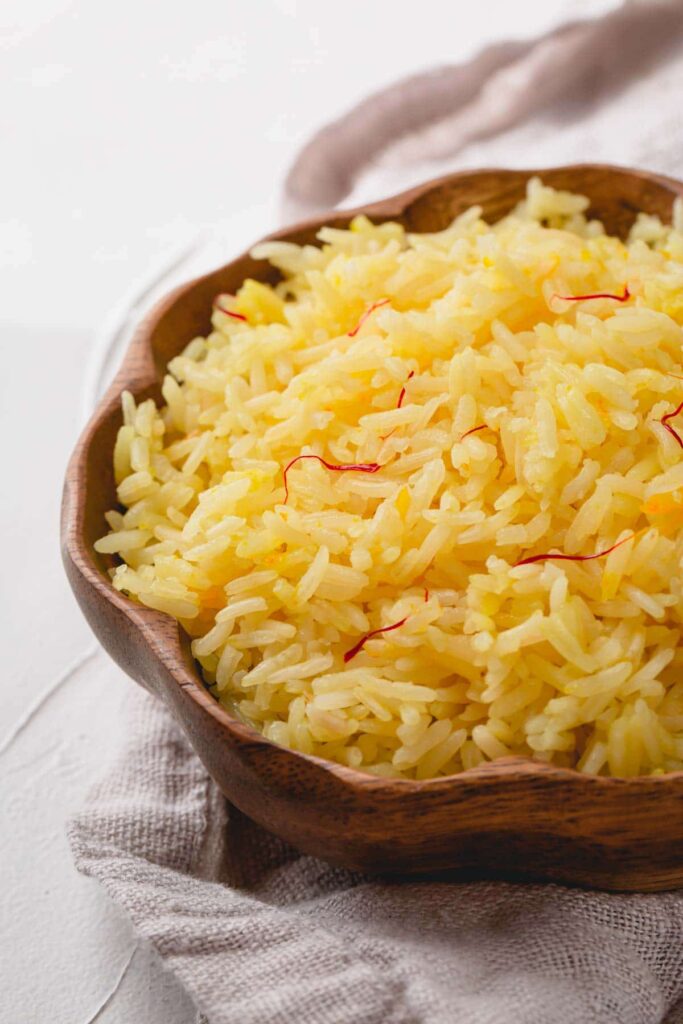
Basmati Saffron Rice
Basmati rice with saffron is an essential side in Middle Eastern diets. Make it in 15 minutes with this easy-to-follow recipe
Ingredient for Basmati Safron Rice
- 2 cups basmati rice
- 4 cups water
- 1-2 tablespoons vegetable oil or butter
- salt to taste
- pinch of saffron (optional)
- 1 teaspoon hot water
Instructions
- Pour the rice into a medium-sized pot.
- Fill up the pot halfway and rinse the water. Discard the water.
- Repeat this step 2-3 times to rinse the rice unit once the water becomes clear. Again, discard the water.
- Add the 4 cups of water, vegetable oil and salt.
- Bring the pot to a boil over high heat.
- Allow the water to continue to boil until the rice has absorbed it and you no longer see any water over top of the rice (roughly 5 minutes).
- Turn the heat down to low and cover the rice.
- Cook for 30-40 minutes.
- Create a saffron-infused garnish: Grind a pinch of saffron using a mortar and pestle. If you don’t have one of those, just grind it in a small bowl using the back of a small spoon. Next, add 1 tsp. of hot water and mix evenly. Take ½ cup of the cooked rice and add it in. Mix well until rice is fully combined and becomes a beautiful yellow colour.
SEE: Korean Corn Dog Home-made Recipes you could Try
Health Benefits of Saffron Rice
Saffron rice adds flavour and visual appeal to a meal and offers several potential health benefits. Here are some of the health benefits associated with saffron rice:
Antioxidant Properties
Saffron contains several bioactive compounds, including crocin, crocetin, and safranal, which act as antioxidants. Antioxidants help protect the body against oxidative stress and damage caused by harmful free radicals associated with various chronic diseases.
Mood Enhancement
Saffron has been traditionally used for its mood-enhancing properties. Studies suggest that saffron may help improve symptoms of mild to moderate depression and anxiety. It may increase the production of serotonin, a neurotransmitter that plays a role in regulating mood.
Anti-Inflammatory Effects
Saffron has shown anti-inflammatory properties in preclinical and clinical studies. It may help reduce inflammation in the body, which is associated with chronic diseases such as heart disease, diabetes, and certain types of cancer.
Digestive Health
Saffron has been used traditionally to aid digestion. It may help improve digestion, reduce gastrointestinal discomfort, and stimulate appetite. Additionally, saffron has been studied for its potential protective effects against stomach ulcers.
Eye Health
Some studies suggest that saffron may have benefits for eye health. It contains carotenoids such as crocin, which may help protect against age-related macular degeneration and improve retinal function.
Potential Cancer-Fighting Properties
Saffron and its bioactive compounds have demonstrated potential anticancer effects in preclinical studies. They may help inhibit the growth of cancer cells, induce cell death, and prevent the formation of tumours. However, further research is needed to better understand the extent of saffron’s effects on cancer in humans.
Weight Management
Saffron has been investigated for its potential role in weight management. Some studies suggest that it may help reduce appetite, decrease snacking between meals, and contribute to feelings of fullness, which could aid in weight control.
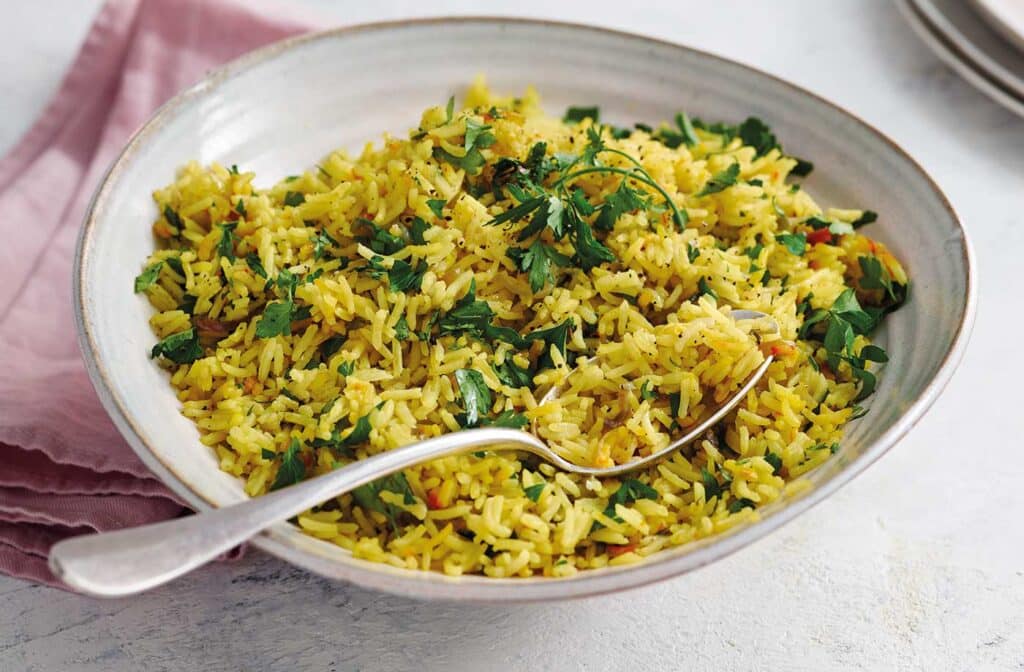
Storing Saffron Rice Recipe
Leftovers can be stored in an airtight container in the fridge for up to 5 days. Rice is generally better fresh, but you can heat up leftovers in the microwave if you have some.
READ ALSO: How to make Egg fried Rice: Best Egg Fried Rice Recipes
FAQs
How does saffron rice taste?
Yellow rice with a flowery, earthy flavour and a touch of sweetness is known as saffron rice. Saffron is mellower than turmeric yellow rice. However, saffron rice still has a distinctive flavour that may also have spicy overtones depending on the variety of saffron used.
What is the difference between saffron rice and yellow rice?
While making yellow rice, the white rice grains can be coloured yellow with saffron or turmeric. Thus, yellow rice can be made with saffron or ground turmeric. So both saffron rice and turmeric rice are two variants of yellow rice.



